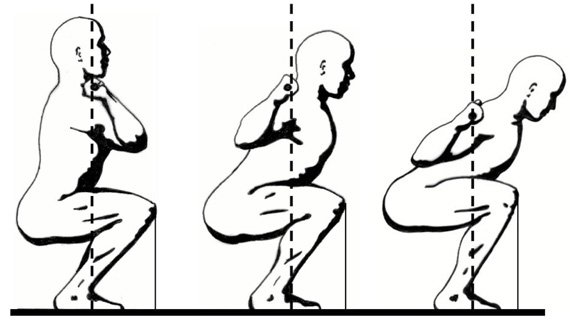Yeah that could be one variable, but I like to think that if I hit a 5RM I would be pretty much fried for the rest of the workout. And the last rep would bascially be a almost failed lift. Honestly though your right it adds too much complexity, an eye bulging 1RM is more functional and then basing your working sets around that is probably best.
Yah, I never do a true max, it's always 90-95% effort level. The 3x5 worksets are also in that range of effort. Yesterday I was more in the 70% effort level because I wanted to make sure to get through all four exercises and get a sense of how work together. I did my squats, bench, press, and dips all within 30 minutes, which means at full sets, reps, and normal effort level, I can get through them in 45-60 minutes, which is about where I want to be. On this morning's 5K, no interfering soreness, but my upper body definitely feels less than satiated after yesterday afternoon's tepid st. Already raring to hit the deadlifts tomorrow.
Catching up lifts is probably something I need to think about too. My squat sucks and I hate doing it. I wonder if I should work at it more after talking through this. Yeah don't get stuck with paralysis by analysis. I like ot talk about it because it helps me stick to a plan and keep me motivated but if its causing too much plan hopping lets change the direction for a while and talk about what are good metrics to track progress or what kind of info would be beneficial in a workout journal.
Not sure what you mean by "catching up lifts"
So many different strength experts seem to think the squat should be the centerpiece to any st program. Rippetoe has his reasons, but the book is at home now so I can't look them up. I hated squats like you, but now I'm getting into them. I think I avoided them because they're more technically challenging. Likewise, it's going to take even more mental effort to get the power cleans right. After that, I'd like to graduate to the power snatch if I can get up the nerve to do them outside. Having a low garage ceiling really stinks. It makes doing my presses awkward as well.
I've been amazed at what a good pump squats give my upper body. I really like starting out each workout with either the squat, deadlift or, starting this week, the power clean. The lower body lifts are actually close to full-body lifts and prime the upper body nicely for the ensuing upper body stuff like presses, rows, and pulls. I think my bar position is still too high on the squats. I have Rippetoe's book in my garage, so next time I'll try to start the st workout a little earlier so I can study up a bit more as I go through the lifts.
I agree these discussions have been extremely fruitful, but really detailed programming isn't going to work for me. I like being aware of all the logics and variations though. It helps me improvise my workouts or weekly routine when I have a better grasp of the fundamental principles at play. In the end though, self-regulation or lifting by feel is probably the way to do. If I continue to follow the 3x5 protocol, it will be more of a guideline than a strict stipulation. Yesterday afternoon, for example, I avoided 1RM and just did 2-3 sets of 5 reps for each lift, but at reduced effort. Tomorrow I'll probably be tempted to do a 1RM on my deadlift, and then I'll do a lot of sets of power cleans as I try to get a better feel for the jump and elbow position. So it's all good.
When I say I'm getting a little burnt out on thinking about this stuff, it only applies to my routine. Please feel free to discuss what you're thinking about in terms of your programming. The 40-workout plan sounds intriguing, and I kind of like the idea of doing 5-6 main lifts per workout, but for me, I think 3-4 is about right. That's 10-15 minutes for each lift, which is enough time for warm-up, one or two sets of 1RM, and then 3 worksets.
I was also encouraged by the article link you posted yesterday, insofar as I seem to have been intuitively following a lot of the basic principles he outlines for intermediate lifters. Rippoetoe's other two books
Should be arriving in a few hours. I'll look them over and let you know if I find any other ideas not mentioned in that article.
They are fun and can be good for you. They probably also lead to better aesthetics. It's just hard to prioritize. I like that about Wendlers 5/3/1 is each 3 week cycle you switch your assistance lifts. But then you are only doing one big lift a day....
Yeh, I'll probably start doing something like that, once my new weekly routine is better established. Right now it's just one assistance lift per workout, but I have a bunch of alternatives listed at the bottom so I can quick look up at the chart taped on my garage door if I have extra time and energy.

But I agree with Rippetoe's principle that you should only work in assistance exercises if they contribute to the main ones. At the moment, I think that's only true of the dips. The loaded carry and landmines I do more because they attack areas not covered by the main lifts. Once the presses and power cleans have caught up to the other lifts, I'll probably go back to doing them once a week, like the other main lifts, and then have more time for other assistance lifts.
It can be fun to push through new boundaries? Progress seems to help me with consistency. Oddly enough I have noticed that the more I lift the more consistently I run. What's interesting is I don't really care too much about becoming a better runner, but in the gym I like to improve. It could just be the benefits of running for me is just being outside enjoying nature, more meditational qualities. In the garage its more fun to chase numbers to elicit soreness and a feeling of progress. Plus you have to admit a 400lb deadlift would be pretty badass while being able to run a decent half mary.
Yah, for me too, there's a really synergy between lifting and running. I know everyone has to find what works for them, but running and lifting seem fundamental to just about any fitness routine. And I agree, making progress, no matter how incremental, helps motivation and thus consistency. It's just a matter of whether we chase specific goals, or let the progress come to us. I've never really chased st benchmarks, so to speak, before, but as I've said, I've never done it consistently for more than 2-3 years at a time either. Whenever I'm traveling or doing fieldwork, I generally stop doing strength training, and it's taken a while to establish st and running as non-negotiable routines in my settled life. I think the am running and pm lifting is going to work for me though. For running, I've been going out without a Garmin since last fall, and really enjoying it. Still, I want to be faster, simply because it feels better. And having used a Garmin in the past, I know 8mm pace feels really good, but even 8:30-9mm consistent aerobic pace would be acceptable at this point. My conditioning has really fallen off since last year.
So, with all that in mind, how's this for provisional goals:
405-pound deadlift
225-pound power clean
175-pound press
24-minute 5K
Two-hour half-Mary
by the end of this year?




























 Practical Programming for Strength Training
Practical Programming for Strength Training  Strong Enough? Thoughts from Thirty Years of Barbell Training
Strong Enough? Thoughts from Thirty Years of Barbell Training 






